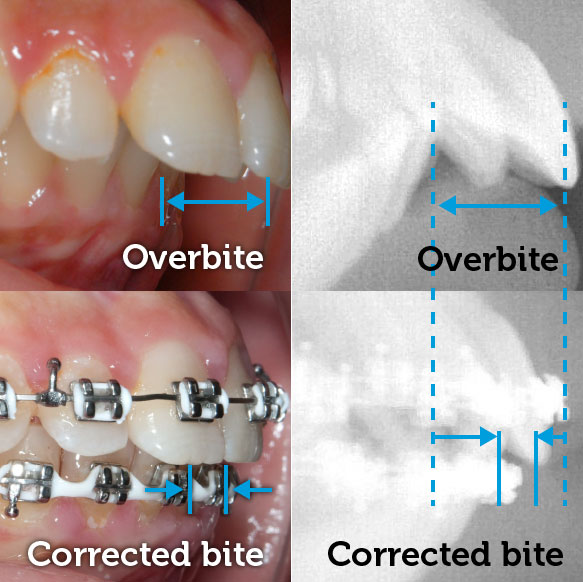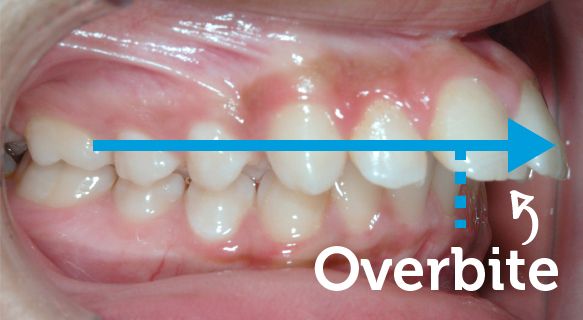Overbite corrected to normal with braces

Top: Photograph and X-ray showing a unhealthy Overbite where the bottom front teeth bite against the top gums. Bottom: Photograph and X-ray of the same patient after correction. Now, the bottom front teeth bite against the top front teeth, as they should.
(Actual patient from Jamesburg, NJ)
Problems caused by overbite
These are the top 3 reasons why an Overbite needs to be fixed:
1. Chipped front teeth: Teeth can chip when the top front teeth stick out too far ahead of the bottom front teeth. Children with flared upper teeth are 3 times more likely to chip their teeth.
2. Worn back teeth: The pointed cusps of teeth will grind together and may wear excessively if the teeth do not bite together properly. The part of the tooth that gets ground down never grows back.
3. Damage to gums: An Overbite causes the bottom front teeth to bite against the gums of the upper teeth. Over time the hard teeth wear away the soft gums.
Correcting an overbite with braces

Overbite happens when the top front teeth stick out too far ahead of the bottom front teeth.
In general, the way an Orthodontist will fix an Overbite is to adjust the position of the teeth so the top and bottom front teeth bite together properly.
The top front teeth need to move backwards and the bottom teeth need to move forward.
The specific way that the bite is corrected will depend on the specific problem. In particular, orthodontists look at whether the problem is with the jaws or with the teeth. For example, the same amount of Overbite can be caused by any of the following:
The top jaw is too far forward in the face: The top teeth are in a normal relationship within the bone, but have been carried too far forward by the growth of the upper jaw. The solution to this is to redirect the growth of the upper jaw. This requires an orthopedic change with Headgear or Orthognathic Surgery.
The bottom jaw is too far backward in the face: The bottom teeth are in a normal relationship within the bone, but have not been carried forward to where they should be because of too little growth of the lower jaw. The solution is to redirect growth of the lower jaw. This requires orthopedic change with a Herbst or Orthognathic Surgery.
The top teeth are flared forward: The top jaw is in the normal position, but the top teeth are ahead of their normal position in the upper jaw. The solution to this is to move the top teeth backwards. This can be done with a Pendulum or removal of upper first premolars.
The bottom teeth are retruded backward: The bottom jaw is in the normal position, but the bottom teeth are behind their normal position in the lower jaw. The solution to this is to move the bottom teeth forward. This can be done with a Forsus or rubber bands.
A combination of problems involving both the jaws and the teeth: Overbites can be caused by a combination of problems. Usually, there has been unfavorable growth of both the upper and lower jaws. The teeth then adapt to the position of the jaws in a way that incompletely compensates for the skeletal disharmony. This kind of Overbite requires a detailed analysis of the contributing factors in order to know how much to redirect growth of jaws and how much to move the top and bottom teeth.
Summary
Overbite is a problem where the top front teeth bite ahead of the bottom front teeth.
The causes of an Overbite are related to the position of the upper and lower jaws and teeth. Not every Overbite is the same - and an Orthodontist is the specialist best trained to determine the cause of a specific Overbite.
Braces and other Orthodontic techniques can fix the problems with Overbite. When the bite is right, the teeth are in a position for lifelong health.